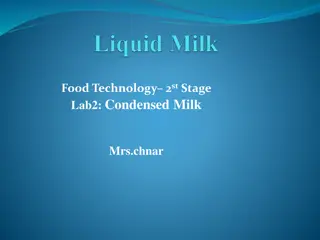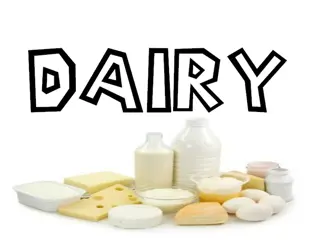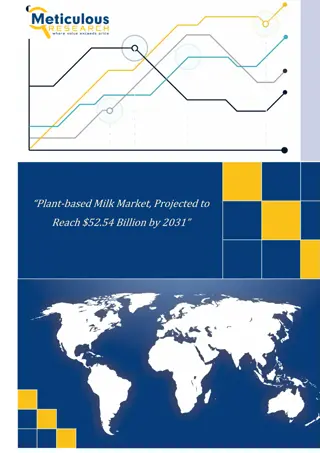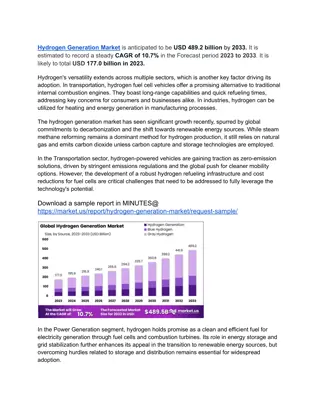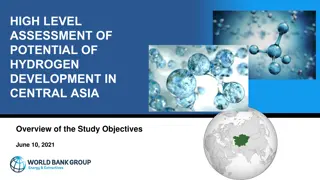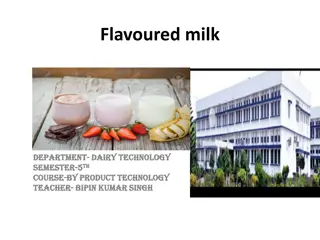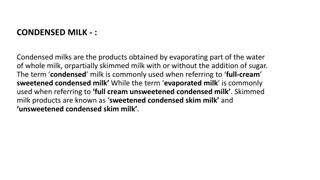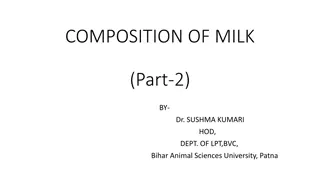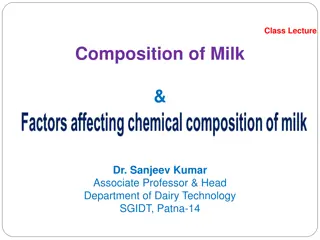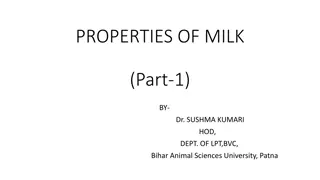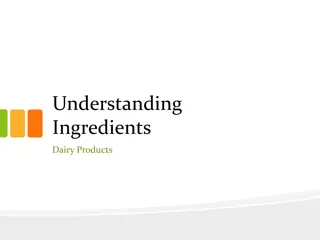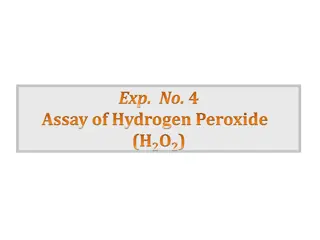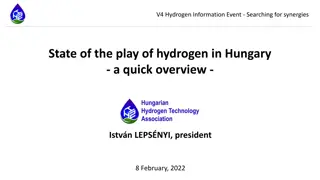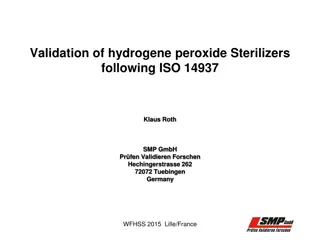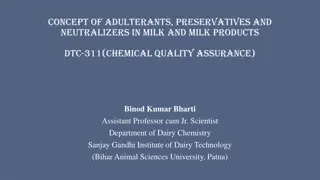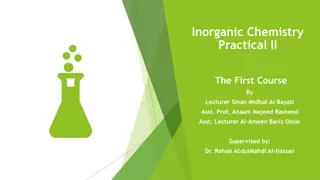Lactoperoxidase/Thiocyanate/Hydrogen Peroxide System in Milk Preservation
An alternative method for preserving milk using the Lactoperoxidase/Thiocyanate/Hydrogen Peroxide (LP) System has been developed. The system combines indigenous antibacterial components with low doses of chemicals to effectively preserve raw milk. The LP system consists of three main components: Lactoperoxidase enzyme, Thiocyanate, and Hydrogen Peroxide. These components react with free sulphydryl groups in bacteria, thereby inhibiting their metabolism and ability to multiply. Milk proteins containing sulphydryl groups are targeted by the LP system, making it a specific and efficient preservation method.
Download Presentation

Please find below an Image/Link to download the presentation.
The content on the website is provided AS IS for your information and personal use only. It may not be sold, licensed, or shared on other websites without obtaining consent from the author. Download presentation by click this link. If you encounter any issues during the download, it is possible that the publisher has removed the file from their server.
E N D
Presentation Transcript
Lactoperoxidase /thiocyanate/hydrogen- peroxide system (LP System) of milk Dr. Sanjeev Kumar Associate Professor-cum-Senior Scientist & Head Dept. of Dairy Technology SGIDT, Patna
INTRODUCTION An alternative method for preserving milk would still be of great advantage in certain situations. Interest was focused on combining an indigenous antibacterial systems with very low dose use of chemicals to determine if these could be applied practically to preserve raw milk. During the last decade research ---- demonstrated that one of these systems, the lactoperoxidase/ thiocyanate/ hydrogen peroxide system (LP- system)--- used successfully for this purpose.
Three components of LP-system 1. Lactoperoxidase enzyme Lactoperoxidase is an enzyme which is found in tissues most mammalian It is present in human saliva and also in bovine and relatively high concentrations. buffalo milk in The average values of Lactoperoxidasecontent: Cow milk 0.452 U/ml Buffalo milk 0.90 U/ml These values are 50-100 times above than what is required to operate theLP-system Lactoperoxidase is quite heat stable
Three components of LP-system 2. Thiocyanate (SCN-) Some thiocyane is present in milk although the level is variable i.e., 1-15 mg/l (5 ppm on average) Thiocyanate content (ppm) Beetroot 100 Cabbage 88.5 Cauliflower 31.5 Spinach 5 Tomatoes 2 Beans 1.4
Three components of LP-system 3. Hydrogen peroxide (H2O2) Present in milk is very small concentration There is evidence of in vivo production ofH2O2by LAB: L. bulgaricus 6-12 ppm L. Lactis 6-12 ppm L. plantarum 3-13ppm L. acidophilus 55 ppm
These agents react specifically with free sulphydryl groups, thereby inactivating several vital metabolic bacterial enzymes (e.g., hexocinase, glyceraldehyde-3-phosphate dehydrogenase) consequently blocking their metabolism and ability to multiply.
LP- s basics As milk proteins contain very few sulphydryl groups and those that are present are relatively inaccessible to OSCN- (masked), the reaction of this compound is in milk quite specific and is directed against the bacteria present in the milk. End products of the intermediates are sulphate, ammonium ions and carbon dioxide At higher levels of H2O2, LP gets inactivated and bactericidal effect is due to toxicity of H2O2 itself
LP-s basics The antibacterial effect of the LP-system is proportional to the thiocyanate concentration in the milk The activation of the lactoperoxidase has a bacteriostatic effect on the raw milk and effectively extends the shelf life of raw milk for 7 8 hours under ambient temperatures of around 30 C or longer at lower temperatures. This allows adequate time for the milk to be transported from the collection point to a processing centre without refrigeration.
The antibacterial oxidation products of thiocyanate are not stable at neutral pH. Any surplus of these Decomposes spontaneously to thiocyanate. The velocity of this reaction is temperature dependent, i.e. more rapid at higher temperatures. Pasteurisation of the milk will ensure a complete removal of any residual concentrations of the active oxidation products. Effect against bacteria is species & strain dependent. Against mixed raw milk flora dominated by mesophilic bacteria bacteriostatic; Against some Gram ve bacteria (pseudomonas, E. Coli) bacteriocidal Due to the mainly bacteriostatic effect of the system it is not possible to disguise poor quality milk, which originally contained a high bacterial population, by applying this method
Practical Application of the Method (as prescribed by CAC) 14 mg of NaSCN is added per litre of milk. The milk should then be mixed to ensure an even distribution of the SCN-. Plunging for about 1 minute with a clean plunger is normally satisfactory. This causes increase the overall level of thiocyanate to 15ppm (around 5 ppm is naturally present). Secondly, 30 mg of sodium percarbonate (2Na2CO3,3H2O2) is added per litre of milk. The milk is then stirred for another 2-3 minutes to ensure that the sodium percarbonate is completely dissolved and the hydrogen peroxide is evenly distributed in the milk This provides an equimolar amount (8.5 ppm) of hydrogen peroxide in the system It is essential that the sodium thiocyanate and sodium percarbonate are added in the order stated above.
Practical Application of the Method The enzymatic reaction is started in the milk when the hydrogen peroxide (sodium percarbonate) is added. It is completed within about 5 minutes from the addition of H2O2; thereafter, no hydrogen peroxide is present in the milk. The activation of the lactoperoxidase system should be carried out within 2-3 hours from the time of milking. Quantities of sodium thiocyanate and sodium percarbonate needed for the treatment of a certain volume of milk, for example 40 or 50 litre, should be distributed to the collecting centre/point in prepacked amounts lasting for a few weeks at a time.
Effect of LP-s on AcidityDevelopment Intervalafter milking (hr) 4 5 6 7 8 9 TA(%LA) Control 0.128 0.135 0.135 0.135 0.137 0.160 (Sl. Sour) LP-treated 0.126 0126 0.126 0.128 0.128 0.122 10 11 12 0.122 0.122 0.153 (Sl. Sour) Extension of three hours in keeping quality achieved
Studies on use ofLP-s Cows milked at 4-6 AM; samples stabilized at 7:30-8:00AM; Temperature 30-32 C Test Treat ment Percentagesample acceptance at 10AM 12AM 100 100 80 60 100 100 70 60 100 100 70 60 100 100 100 100 *Cut off 0.16%LA 2 PM 70 10 80 20 90 30 100 90 4PM 50 0 60 0 60 10 100 30 6PM 30 0 50 0 50 10 80 30 Ten min resazurin LP C LP C LP C LP C Acidity* Alcohol stability COB
Microbiological Effects & Performance of LP-s Effectiveness of LP-s depends on three factors: milk, bacterial cell density &type oforganism storage temperatures of Temperature( C) 31-35 30 25 20 15 4 Time (hrs) 4-7 7-8 11-12 16-17 24-26 5-6 days LP-s persists only for limited time-period which decreases ambient temperature increases LP-s relevant to low temperature storage due to the growth Pseudomonasspp. &Lysteriamonocytogenes The efficacy is low at high bacterial concentrations as the of
Performance of LP-s at Different bacterial loads The efficacy is low at high bacterial concentrations NaSCN : 15 ppm, H2O2 10ppm Addition after 3 hrsof milking Incubation temperature 37 C Bacterial count (SPC/ml) 6.7 x106 6.4 x107 8.2 x107 MBRTime (hrs) 8.5 5.0 3.0
MicrobiologicalEffects& Performanceof LP-s Antimicrobial activity of LP-s has been against a wide range of microorganisms, e.g., bacteria, HIV-1 virus, moulds, yeasts, mycoplasma &protozoa demonstrated Depending upon the bacterial species or even the strain of the microorganism the effect can be bacteriostatic or bactericidal LAB:sometimes self-inhibitory, Catalase +ve are not
Impact of LP-s on Some Common Milk-borne Pathogens Effect of LP-s E. Coli including E. Coli 0157:H Reduced gastrointestinal colonization rate of coliform bacteria Salmonella typhimurium (depending on No. of mos) Salmonella typhimurium & other Salmonella spp. Camphylobactor jejuni Staphyloccus aureus Bactericidal & Bactriostatic Lysteria monocytogenous (Depending on temp. , time & strain) Yersinia enterocolitica Brucella melitensis Bactericidal Pathogen Demonstrated in Raw cow milk Bactericidal Raw cow, goat & camel milk, culture medium and infant formula Raw milk Bactericidal & Bactriostatic Bactericidal Culture medium, infant formula and fresh cheese Bactericidal Cow milk Cow, goat & camel milk Raw cow & goat milk, UHT milk, soft cheese Bactericidal & Bactriostatic Bactericidal Cow milk Goat milk
HealthIssuesAssociates with the use of LP-s The percarbonate is very low and not of concern levels of H2O2 introduced into the milk via sodium As there is no change to the enzyme concentrations present in milk, this component is not considered of toxicological significance naturally Thiocyanate interferes with iodine metabolism and uptake by the thyroid, especially in Iodine deficient subjects hence a potential goitrogenic substance
Effect of LP-s on serum thiocyanatelevel 400 ml milk daily containing 20 ppm NaSCN (equivalent to 8 mg of thiocyanate daily) Time interval (weeks) Serum thiocyanate level (mg/L) [Non- smokers] Serum thiocyanate level (mg/L) [Smokers] 0 4 8 12 4.0 7.8* 6.9 7.0* 8.4 10.7 10.1 8.9 *Significant increase over initial Level >18 cause impaired thyroid function
Effect of LP-s on Milk Processing & Technology No effect onsensorial attributes of milk The flavour of fermented goat s milk & cheese result of action of lactoperoxidase improves as a Interaction of lactoperoxidase with SH groups of proteins could alter the texture of gelled products Evidenceof the last phenomena is mixed Some evidence of slower rennet clotting and weaker cheese, and lower acid production in yoghurt gels in If the LP-s treated milk has been subjected to treatment no effects on the quality of cheese and fermented milk products adequate heat-
Effect of LP-s on Milk Processing & Technology LP-s has a clear potential for inhibition of lactic starter Susceptibility of lactic acid starter bacteria can be categorized into three groups as follows: 1.The most sensitive group of organisms which generate hydrogen peroxide, e.g., Lactobacillus acidophilus, Lactobacillus bulgaricus 2.Organisms that are sensitive but do not have the ability to generate hydrogen peroxide and thus require an exogenous source of hydrogen peroxide e.g., Lactobacillus helveticus, S. thermophilus 3.Organisms resistant to inhibition e.g., Lactococcus lactis.
Intended Utilization of theMethod The method should primarily be used to prevent undue multiplication in raw milk during collection and transportation to the dairy processing plant bacterial This method should only be used in situations when economical and/or practical reasons do not allow the use of cooling facilities for maintaining the quality of raw milk. technical, Use of the LP-system in areas which currently lack an infrastructure for collection of liquid milk, would ensure the production of milk as a safe and wholesome virtually impossible. adequate food, which otherwise would be The method should not be used by the individual milk producer but at a suitable collecting point/centre. These centres must be equipped with proper facilities for cleaning and sanitizing the vessels used to hold and transport milk.
Current status of use of LP-s Current worldwide milk output 660 MMT (approx.) Around 40% is contributed by developing world with small dairy farmers contributing about 70% of the total Though the cost of milk production is low in developing countries they are net milk importers The World Bank estimates that 20% of milk in developing countries is wasted due to high capital investment in refrigeration and can incur high running and maintenance costs Use of LP-s is a reliable & economical method of preserving raw milk as compared to refrigeration in small-scale dairy enterprises, coupled with good hygiene and sanitation.
Using LP-sfor preservingevening milk Five times increase in SCN & H2O2(75:50 ppm) increase the keeping quality of raw milk up to 15 hrs Upon addition of second dose of H2O2on the 10thhr the keeping quality was increased up to 18hrs The 18 hrs shelf life would permit the collection of evening milk with LPtreatment along with untreated morning milk Mixing of these two milks at the dairy would bring down the SCN level to the CACrecommended level 15ppm
Cuba & Latin America Example In Cuba, more than 50% of the milk is not refrigerated due to high cost of cooling equipment and lack of electricity Use of the LP-s has allowed significant quantities (50,000 MT) of milk, valued at US$100m (over 13 yrs), which would otherwise have been lost, to enter the food chain In Latin America, 30m litres of milk was activated using the LP-s in last five years Fifty percent of the milk that would otherwise be lost is saved through the LP-s, amounting to a value of around US$3 m
Currentstatus There is a codex provision that the LP-s should not be used for products intended for international trade The LP-s is not adopted in the first place in some because of a fear of being excluded from international markets. countries If products treated with the LP-s are not considered suitable for international trade then this raises doubts as to whether it is appropriate and safe to use for milk and dairy products in the domestic market
Indian Scenario NaSCN : 15 ppm, H2O2 10 ppm, after 3 hrs of milking, incubation temperature 37 C Samples were taken after one hour of activation of the LP-s TrialNo. SPC/ml MBRT(hrs) Control 6.50 3.50 1.75 2.0 3.25 Control 6.8 x 106 6.4x 107 8.2 x107 1.4 x 107 2.6 x107 Treated 4.8x 105 9.5 x105 2.2 x107 7.5 x106 2.9 x106 Treated 8.5 5.0 3.0 4.5 5.25 1 2 3 4 Average
IndianScenario LP-s have not been approved: Dairy development policy is based on Clean milk production Monitoring is aproblem Confused with pure chemical preservation Concern about SCN Long term implication development of LP-s or anti body resistance stain In India use of any chemical preservative for raw milk processed/used for human consumption is not permitted to pre
THANKS 30



